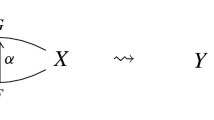Abstract
We prove a conjecture of Cautis and Sussan providing a categorification of the Boson-Fermion correspondence as formulated by Frenkel and Kac. We lift the Bernstein operators to infinite chain complexes in Khovanov’s Heisenberg category \({\mathcal {H}}\) and from them construct categorical analogues of the Kac-Frenkel fermionic vertex operators. These fermionic functors are then shown to satisfy categorical Clifford algebra relations, solving a conjecture of Cautis and Sussan. We also prove another conjecture of Cautis and Sussan demonstrating that the categorical Fock space representation of \({\mathcal {H}}\) is a direct summand of the regular representation by showing that certain infinite chain complexes are categorical Fock space idempotents. In the process, we enhance the graphical calculus of \({\mathcal {H}}\) by lifting various Littlewood-Richardson branching isomorphisms to the Karoubian envelope of \({\mathcal {H}}\).




Similar content being viewed by others
Notes
In his original paper, Khovanov only proved injectivity \(\mathfrak {h} \hookrightarrow K_0({\mathcal {H}})\) and conjectured surjectivity. The full bijection was not proved until much later in a recent paper by Brundan, Savage and Webster [1].
The complexes \(\mathsf {B}_a, \;\mathsf {B}_a^*\) are equivalent to the complexes \(\mathsf {C}_a, \mathsf {C}_a^*\) originally defined by Cautis and Sussan via the involution \(a\mapsto -a\) and a homological grading shift of [a].
For completeness, we mention that its unique irreducible module \(F_U\), i.e its spin module, is given by the maximal isotropic subspace \(U=\bigoplus _{i \le 0} \mathbb {k} \psi _i + \bigoplus _{i>0} \mathbb {k}\psi _i^*\) with the property that \(U(\overline{0})=0\). This fact will not be used here.
Macdonald uses the notation \(B^\perp _a\) instead of \(B^*_a\).
References
Brundan, J., Savage, A., Webster, B.: The degenerate Heisenberg category and its Grothendieck ring. (2019) arXiv:1812.03255
Cautis, S., Licata, A.: Vertex operators and 2-representations of quantum affine algebras (2011). arXiv:1112.6189
Cautis, S., Licata, A.: Heisenberg categorification and Hilbert schemes. Duke Math. J. 161(13), 2469–2547 (2012)
Cautis, S., Licata, A.: Loop realizations of quantum affine algebras. J. Math. Phys. 53(12), 123505, 18 (2012)
Cautis, S., Licata, A., Sussan, J.: Braid group actions via categorified Heisenberg complexes. Compos. Math. 150(1), 105–142 (2014)
Cautis, S., Sussan, J.: On a categorical Boson-Fermion correspondence. Commun. Math. Phys. 336(2), 649–669 (2015)
Cvitanovic, P.: Group Theory: Birdtracks, Lie’s and Exceptional Groups. Princeton University Press, Princeton (2008)
Date, E., Jimbo, M., Kashiwara, M., Miwa, T.: Transformation groups for soliton equations: Iv. a new hierarchy of soliton equations of kp-type. Physica D Nonlinear Phenom. 4(3), 343–365 (1982)
Elias, B., Hogancamp, M.: Categorical diagonalization (2017). arXiv:1707.04349
Frenkel, I.B., Jing, N., Wang, W.: Vertex representations via finite groups and the McKay correspondence. Int. Math. Res. Not. 195–222, 2000 (2000)
Frenkel, I.B., Kac, V.G.: Basic representations of affine Lie algebras and dual resonance models. Invent. Math. 62, 23–66 (1980)
Frenkel, I., Penkov, I., Serganova, V.: A categorification of the boson-fermion correspondence via representation theory of \(sl(\infty )\). Commun. Math. Phys. 341(3), 911–931 (2016)
Frenkel, I.B.: Two constructions of affine lie algebra representations and boson-fermion correspondence in quantum field theory. J. Funct. Anal. 44(3), 259–327 (1981)
Fulton, W.: Young Tableaux: With Applications to Representation Theory and Geometry. London Mathematical Society Student Texts. Cambridge University Press, Cambridge (1996)
Gaberdiel, M.R.: An introduction to conformal field theory. Rep. Progress Phys. 63, 10 (2000)
Gaberdiel, M.R.: 2D conformal field theory and vertex operator algebras (2005). arXiv:hep-th/0509027
Garcia, A.: Young seminormal representation, Murphy elements, and content evaluations. http://www.math.ucsd.edu/~garsia/somepapers/Youngseminormal.pdf, (2003)
Geissinger, L.: Hopf algebras of symmetric functions and class functions. Combinatoire at représentation du groupe symétrique 579, 168–181 (1976)
Hogancamp, M.: Idempotents in triangulated monoidal categories (2017). arXiv:1703.01001
Hill, D., Sussan, J.: A categorification of twisted Heisenberg algebras. Adv. Math. 295, 368–420 (2016)
Jing, N.: Vertex operators and Hall-Littlewood symmetric functions. Adv. Math. 87(2), 226–248 (1991)
Jing, N.: Vertex operators, symmetric functions, and the spin group \(\gamma _n\). J. Algebra 138(2), 340–398 (1991)
Kac, V.G.: Infinite-Dimensional Lie Algebras, 3rd edn. Cambridge University Press, Cambridge (1990)
Kac, V.: Vertex algebras for beginners, volume 10 of University Lecture series. American Mathematical Society, 2nd edition (1998)
Khovanov, M.: Heisenberg algebra Lauda, A.: unpublished notes. (2009)
Licata, A., Savage, A.: A survey of Heisenberg categorification via graphical calculus. Bull. Inst. Math. Acad. Sin. (N.S.) 7(2), 291–321 (2012)
Macdonald, I.G.: Symmetric Functions and Hall Polynomials. Oxford Mathematical Monographs. The Clarendon Press Oxford University Press, 2nd edition, (1995)
Miwa, T., Jimbo, M., Date, E.: Solitions, volume 135 of Cambridge Tracts in Mathematics. Cambridge University Press (2000)
Raicu, C.: Products of Young symmetrizers and ideals in the generic tensor algebra. J. Algebraic Comb. 39(2), 247–270 (2014)
Rosso, D., Savage, A.: A general approach to Heisenberg categorification via wreath product algebras. Math. Z. 286(1–2), 603–655 (2017)
Zertuche, R.R.: An introduction to the half-infinite wedge. Contemp. Math. 657, 198–237 (2016)
Savage, A.: A geometric boson-fermion correspondence (2007). arXiv:math/0508438
Segal, G.: Unitary representations of some infinite dimensional groups. Commun. Math. Phys. 80, 301–342 (1981)
Stern, E.: Semi-infinite wedges and vertex operators. Int. Math. Res. Not. 5, 201–220 (1995)
Tian, Y.: Towards a categorical boson-fermion correspondence (2017). arXiv:1710.11579
Tingley, P.: Notes on Fock space. http://webpages.math.luc.edu/~ptingley/, (2011)
Kroode, F., Leur, J.: Bosonic and fermionic realizations of the affine algebra \(\widehat{{\rm gl}}_n\). Commun. Math. Phys. 137, 67–107 (1991)
Yanagida, S.: Boson-fermion correspondence from factorization spaces. J. Geom. Phys. 124, 55–63 (2018)
Zelevinsky, A.V.: Representations of Finite Classical Groups, volume 869 of Lecture Notes in Mathematics. Springer (1981)
Acknowledgements
I am deeply grateful to Matt Hogancamp for innumerable conversations and Aaron Lauda for suggesting this project and his encouragement and support throughout. Sincere thanks also go to Tony Licata and Josh Sussan for beneficial discussions and Mikhail Khovanov, Alistair Savage, and Geordie Williamson for detailed suggestions on earlier versions of this work. I would also like to thank Yin Tian for pointing out an extra relation in a theorem as well as the anonymous referees for excellent suggestions and comments. The author was partially supported by NSF grants DMS-1255334 and DMS-1664240.
Author information
Authors and Affiliations
Corresponding author
Additional information
Publisher's Note
Springer Nature remains neutral with regard to jurisdictional claims in published maps and institutional affiliations.
Appendix A: Examples
Appendix A: Examples
1.1 A.1.
Let \(a=2\) and \(b=3\). By Theorem 6.6 we know that \(\mathsf {B}_1 \otimes \mathsf {B}_3 \simeq \mathsf {B}_2 \otimes \mathsf {B}_2 [1]\). We show explicitly how such an equivalence could be true. In particular, \(\mathsf {B}_2 \otimes \mathsf {B}_2\) is given by total complex of the bi-complex,

Applying Proposition 4.6 followed by Proposition 4.8 we obtain an isomorphism with the bi-complex,

Applying Lemma 3.7 along the isomorphisms denoted in red, we see that
Likewise, \(\mathsf {B}_1 \otimes \mathsf {B}_3\) is given by the total complex of the bi-complex,

which after applications of Propositions 4.6 and 4.8 becomes,

Once again, cancelling summands along the isomorphisms in red and blue, by Lemma 3.7 we have
Continuing in this manner along all homological degrees it becomes apparent how one obtains the homotopy equivalence \(\mathsf {B}_1 \otimes \mathsf {B}_3 \simeq \mathsf {B}_2 \otimes \mathsf {B}_2[1]\).
1.2 A.2
Now suppose \(a=b=2\) and consider \(\mathsf {B}_1 \otimes \mathsf {B}_2\). By Theorem 6.6 this product should be nullhomotopic. To see why, consider the following bi-complex,

Once again, by Propositions 4.6 and 4.8 there an isomorphism with the bi-complex below, with isomorphisms along the red and blue arrows.

After applying Lemma 3.7 along the red and blue isomorphisms, all chain groups in homological degrees zero and one can be canceled. Continuing in this manner one can eliminate the summands in all degrees, thus obtaining the desired nullhomotopy.
1.3 A.3
Lastly, let \(a=1\) and \(b=2\) and suppose \(\mathsf {Q}^{\otimes 4} =0\). By Theorem 6.14 we know that \(\mathsf {B}_1 \otimes \mathsf {B}_2^* \simeq \mathsf {B}_1^*\otimes \mathsf {B}_0\). In particular, we have that \(\mathsf {B}_1 \otimes \mathsf {B}_2^*\) is given by the total complex of the bi-complex below,

Thus, after applying Lemma 3.7 along the isomorphism in red, we see that
Now, if we consider \(\mathsf {B}_1^* \otimes \mathsf {B}_0\) we see it is the total complex of the bi-complex

which after applying Propositions 4.6 and 4.7 is homotopic to,

But \(\mathsf {Q}^{(2,1)}=\mathsf {Q}^{(2,1)^t}\), thus after Gaussian elimination along the isomorphisms in red we obtain
Rights and permissions
About this article
Cite this article
González, N.S. Categorical Bernstein operators and the Boson-Fermion correspondence. Sel. Math. New Ser. 26, 51 (2020). https://doi.org/10.1007/s00029-020-00558-6
Published:
DOI: https://doi.org/10.1007/s00029-020-00558-6




